Miscellaneous
-
Ticket Rewind
published: 11 /
3 /
2019
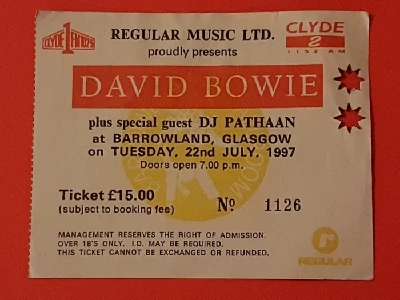
In our new series 'Tickets Rewind', in which our writers look back at their old concert tickets and the stories associated with them, our Editor John Clarkson reflects on some of his favourite gigs.
Article
It is with some regret that I look back on my old concert tickets. While I have kept most of them since 1988, there are a lot that have been lost, three, for example for Iggy Pop shows in the late 1980s and early 90s, one at the Edinburgh Playhouse and two at the Glasgow Barrowland, and another beautiful art ticket for Peter Gabriel at the Glasgow SECC in 1993. In a particulary stupid moment, I threw away as well all my my tickets from university when I was packing up to go home to Edinburgh after three years away between 1983 and 1986 at Loughborough - an entire set of heirlooms from my early musical education with Squeeze, OMD, Public Image Ltd, Tom Robinson, Dr Feelgood and New Order.
Of the many tickets that remain, they are a simple and uncomplicated access to the past. These are some of them, and the memories that are associated with them.
The Waterboys, Playhouse, Edinburgh, 12th September 1990
Over the last thirty years I have seen Mike Scott’s the Waterboys in their various incarnations or Scott on his own maybe a dozen times. This 1990 gig at the Edinburgh Playhouse, one of the first on an extensive tour, found Scott and his band of folk rockers at a low ebb. Their fifth album, ‘Room to Roam’, was about to be released to bad reviews, and while it has its moments – ‘A Man is in Love’, ‘Something That is Gone’ and ‘A Life of Sundays’ are all magical – it is a patchy affair in comparison to its four predecessors.
Their fiddle player Steve Wickham and Scott’s then main musical muse had also quit directly before the tour when he and Scott had had a row over musical direction. The Waterboys had been due to go out as septet, but were reduced to a four-piece as another two members had left with Wickham.
It was not a good night for the Waterboys. There was a lot of swapping around of instruments to compensate for the three missing members, and they were under-rehearsed. They played several tracks from the new album and a few old favourites but, unusually for them, an act who have always played lengthy sets, they were on and off stage in less than an hour. Scott finished the set with a tirade against Wickham before launching into a particularly caustic version of their first self-titled album’s closing track, ‘Savage Earth Heart’.
It was the first gig that I went to with my girlfriend Mo. We were friends for about a year beforehand and it took us another few months after to become an item. Twenty-eight years later we are still together. We have been through a lot with one other, good times and also some very sad times, involving illness and the deaths of friends and family. We have also been to a lot more gigs with each other, and many more Waterboys’ shows which has found them back on form and Wickham returned to the fold. That gig was, however, one of the most memorable, and the start of a love affair.
The Velvet Underground, Edinburgh, PLayhouse, 1st and 2nd June 1993
In those days before Ticketmaster you had to queue outside the venue or the ticket office on the day they went on sale or the night before to be guaranteed tickets.
I had become an obsessive fan of the Velvet Underground well over a decade after they had split in 1970 and almost another decade before in 1984 after discovering them during my first year at university.
It still seems dream-like twenty-six years on that they should choose my home city to open the first two nights of their ill-fated European tour, and I found myself, one of the first fifty in the queue, standing outside The Playhouse one Spring Sunday morning at 6 a.m. waiting for their ticket office to open at 10.
I bought tickets for both nights. The tired girl behind the ticket counter misspelt their name as ‘Velvet Undreground’ before printing off my ticket for the first night, but got it right for the second evening.
I was in those days more of a Lou Reed fan, who I had seen the year before on his ‘Magic and Loss’ tour, than the other members of the band, and had been obsessed for years by the raw quality of the voice and his tales of the street. It is the others, however, who I remember better from each night – Maureen Tucker’s metronome-perfect, stark drumming; guitarist Sterling Morrison, who was to die just two years later aged only 53, almost stock-still on stage as he played his first gig in over twenty years; and the magnificent John Cale, bringing both his waspish electric viola to ‘Venus in Furs’ and his lilting, soft Welsh accent to ‘The Gift’.
Of course, it all went horribly wrong. Old insecurities, egos and wounds had all flared at the rehearsals before the tour, and by the time they had got to London a few nights later Reed and Cale in particular were apparently at each other’s throats. They never played again together after the tour ended two weeks later in Paris. What I remember though from those two nights at The Playhouse is a sense of truce and harmony, and, as they finished on their second night with ‘Coyote’, their first and as it transpired only new song since the original split, a temporary feeling of real hope for the future for the Velvet Underground.
The Kinks, Barrowland Ballroom, Glasgow, 18th October 1994
The Barrowland Ballroom was the focus for a lot of the best bands in Central Scotland in the 1990s. While it has lost some of its drawing power with groups in Glasgow in recent years with the rise of two O2 venues, one of which was destroyed last year by fire, it remains an iconic venue for most serious Scottish gig-goers.
I had always liked the Kinks without ever being a huge fan of them. That all changed the night I saw them play a gig a surprisingly only half-full room at the Barrowland to promote ‘To the Bone’, an album of reworkings and new recordings of classic material. They played essentially a greatest hits set, ‘All Day and All of the Night’, ‘Waterloo Sunset’, ‘Sunny Afternoon’. ‘The Village Green Preservation Society’, ‘Lola’ and ‘You Really Got Me’ (the latter of which Ray Davies told us, as he also wrote on the sleeve notes of ‘To the Bone’, that they “had played a thousand times and in a thousand different ways.”). As they started each of those songs, they exploded one after another into technicolor for me. The only song that I didn’t know was the best one of all of the night, ‘I’m Not Like Everybody Else’, the B-side to ‘Sunny Afternoon’, which as an appreciative roar went up from the crowd, many of whom had obviously also never heard it before, I remember Ray Davies, despite his brother Dave having sung the lead, describing simply as a “good song.”
With the Kinks, I have never looked back since then. Sometimes it can take a gig to bring things together.
David Bowie, Barrowland Ballroom, Glasgow, 22nd July 1997
I saw David Bowie twice, both times within twenty months of each other during a particularly fertile period in his career and at two very different gigs in Glasgow.
On the first occasion in November 1995 it was with 10, 000 others at the SECC, which was then Scotland’s biggest venue. Morrissey had been brought in as the support act for the tour, which was to promote Bowie’s ‘Outside’ album. It was supposed to be a dream bill, but, while he had completed a handful of dates prior to then, he dropped out of the tour on the night of the Glasgow gig. We were told that he was ill, but I think, few of the audience, given his volatility, believed that. We were proved right, as he did not return for the other dates. I remember both Mo and I fuming at him - not for the last time - for treating both his own and Bowie’s fans in such a shitty way and for being such a tantruming, ungracious baby. I remember also being very impressed with the support band, a local indie act called the Gyres, who had been drafted in at two hours’ notice to replace Morrissey and who rose to the occasion. Of Bowie himself though, I am ashamed to say that I remember next to nothing.
The second occasion in July 1997 was at the Barrowland, which has a capacity of about 2,000, and was much more memorable. ‘Jean Genie’ was thrown early on in the set. It is a song of his that I had never been that bothered about until then, but once again in a live setting it came really alive to me for the first time. There were stunning versions as well of ‘FAme’ and ‘Under Pressure’, the latter of which Bowie co-sung with bassist Gail Anne Dorsey. Equally captivating, however, were the songs from his then new album, ‘Earthling’. As much as I love ‘Outside’, I like ‘Earthling’ a little better. It is my favourite of his latter albums, and songs from it such as ‘Battle of Britain’, ‘Looking for Satellites’ and ‘I’m Afraid of Americans’ played live were absolutely gripping.
Bowie, wearing the Union Jack coat he wore on the front cover of ‘Earthling’, was charismatic, and his band , which as well as Dorsey, also featured guitarist Reeves Gabriel and pianist Mike Garson, were supposed to play two sets. They went off for what Bowie said would be a fifteen minute break, but realising they were running tight for time and up against the 11 p.m. Barrowland curfew were back on stage less than thirty seconds later and accelerated through several more numbers before leaving without an encore. It was a rare occasion to see Bowie in an intimate setting.
Willard Grant Conspiracy, Riverside Club, Glasgow, 21st June 1999
Of all the bands that I have worked with at Pennyblackmusic, it is the Willard Grant Conspiracy that has mattered the most to me. They were the second band that I wrote about after Pennyblackmusic started in September 1998, and their Californian-born frontman Robert Fisher was the subject of my first interview, a fifteen minute phone conversation organised by a PR, in April 1999 to promote their just released third album, ‘Mojave’. Even now over twenty years after I first heard many of their songs, Robert’s deep baritone vocal and his melancholically beautiful songs about alcohol, fallen women and religion continue to have a hold on me.
While the Willard Grant Conspiracy had toured in Britain before, this gig - a couple of months after I did the interview - was their first Scottish show and took place in a long demolished venue in a back street in Glasgow near the River Clyde and not far from St Enoch shopping centre.
That night their songs - ‘No Such Thing as Clean’, ‘St John Street’ and ‘Bring the Monster Inside' from their second album ‘Flying Low’ and ‘How to Get to Heaven’, ‘The Work Song’ and set closer ‘The Visitor’ from ‘Mojave’ - which had come to mean such a lot in recent months sounded even more powerful live.
I briefly spoke to Robert that night, and introduced myself. The Willard Grant Conspiracy were over a lot from Boston where they were then largely based in those days, and at their second Scottish show four months later at the Renfrew Ferry a few hundred yards away on the opposite side of the Clyde Robert remembered me when we spoke again. Gradually at other Willard Grant Conspiracy gigs we would become friends, and I would go on and interview him every time he had an album out on another seven occasions and see the Willard Grant Conspiracy about twenty times. Pennyblackmusic would also latterly promote four Willard Grant Conspiracy gigs, two in London, one in Glasgow and one in Edinburgh. Robert died two years ago in February 2017, at the age of just 59 from cancer, and I miss him a lot.
Part of the joy of seeing the Willard Grant Conspiracy live was that they rarely played with the same line-up twice. Robert would go out with whoever was available, and would often half joke on stage and in interviews that the Willard Grant Conspiracy had upwards of 45 members. Guitarist Paul Austin was his main early collaborator, and viola player Dave Curry his latter one. Both were there that night, and in a lovely twist of fate I would go on to interview both of them eventually about their own projects, the Transmissionary Six and the Empty house Cooperative as well as that tour’s keyboardist Peter Linnane about his band Linnane and also many years later support act Peter Bruntnell.
As Mo and I ran out as ‘The Visitor’ was closing in its rush of distortion to get the last train back from Queen Street Station to Edinburgh, everything that I had been thinking during the last year had crystalised, that this band was really special. That was something that was confirmed time and time again in the years to come.
The Stereogram Revue, Voodoo Rooms, Edinburgh, 2nd December 2015
As Jeremy Thoms said, when his band the Cathode Ray were playing the last set of the night, they really needed about a hundred more people in the audience. The aim of the Stereogram Revue was to showcase with twenty-five minute sets all the current acts on the fine Edinburgh-based indie label Stereogram Recordings with two shows in Edinburgh and Glasgow.
Unfortunately the show in Edinburgh had no more than thirty people excluding the acts on the bill in the audience. Maybe it was just too close to Christmas. I know, however, as an occasional promoter that sometimes the gigs you expect to do well do badly and vice versa, and that there is little point in trying to over analyse these things when they can go wrong, that they can happen often inexplicably no matter how hard you have tried to push them, and that all you can do is hope for better fortune another time.
The Stereogram Revue had the potential for disaster in other ways too. Fife duo Milton Star, despite being billed on the ticket, had dropped out, having no live set-up and for all purposes having effectively split up. Glasgow two-piece Lola in Slacks had also pulled out at the twelfth hour, citing illness.
Yet out of all of this, there was a lot of magic on the night. The Cathode Ray were as solid as always. St Christopher Medal, who had travelled through from Perthshire, had got off to a shaky start when they nearly missed their soundcheck after they had become stuck in a traffic hold-up on the Forth Road Bridge. Yet in what was only their secoond gig they played an absolutely beguiling and charming set of songs from their years-in-the-making debut album, 'Sunny Day Afternoon'. Roy Moller had formed a one-off, makeshift band of disparate friends, which he christened the Mollermen, but, despite playing a mildly chaotic set, the chemistry between them was such that they became for a while a more permanent band. The Band of Holy Joy, who were signed to Stereogram at the time, had been unable to make the trip up from London, but had sent along frontman Johny Brown's close friend Tam Dean Burn to perform what was dubbed the 'Scrap and Salvage Movement', a recital of Brown's lyrics set aginst the group's music and Inga Tillere's haunting visuals. It was one of most bizarre and unusual but under Burn gripping performances to take place pm a Stereogram stage. James King and the Lonewolves' bassist Nick Clark had forgotten to turn up and wasn't answering his phone. With one of the group's twin guitarists Jake Mckechan also absent for more official reasons, the remaining trio, clearly absolutely furious at Clark, played a caustic, angry set and what the diehard Lonewolves' fans in the audience said was the gig of their career.
Whwn Jeremy Thoms left the stage with the Cathode Ray, he was given a standing ovation by most of the small audience. It was a pity that so few were there, as for there that were it was an enrichening experience.
Photos by Mo Robertson
Picture Gallery:-
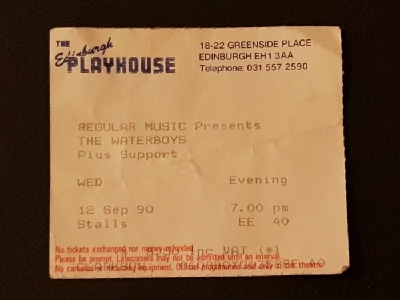
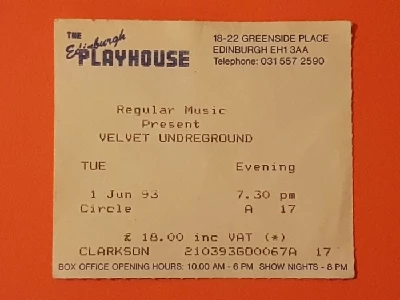
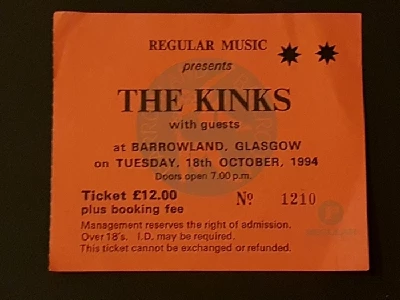
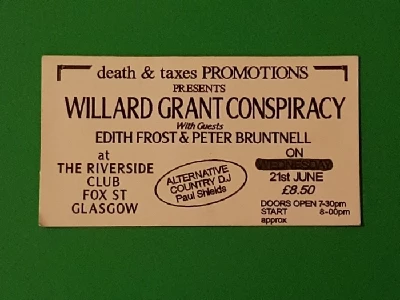

Visitor Comments:-
|
|
888 Posted By: John, Edinburgh on 16 Mar 2019 |
Thanks, Graham. I wouldn't swear on it but I think at that show which turned out to be sadly the WGC's final Scottish show that it was 'The Ocean Doesn't Want Me', which is a cover of a Tom Waits song, from their 'Paper Covers Stone' album.
|
|
887 Posted By: Graham Drysdale, Edinburgh on 16 Mar 2019 |
Brilliant John. Touching. I was at the VU gigs too, couldn’t quite believe it was happening. Willard Grant Conspiracy were great at the Wee Red Bar. What was their long last song that night?... Makes me regret that I’ve not been to more gigs over the years.
|